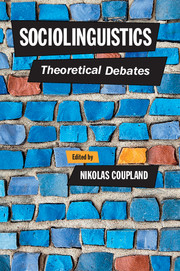Book contents
- Frontmatter
- Contents
- List of contributors
- Preface and acknowledgements
- 1 Introduction: Sociolinguistic theory and the practice of sociolinguistics
- Part I Theorising social meaning
- Part II Language, markets and materiality
- Part III Sociolinguistics, place and mobility
- Part IV Power, mediation and critical sociolinguistics
- Part V Sociolinguistics, contexts and impact
- 15 Are there zombies in language policy? Theoretical interventions and the continued vitality of (apparently) defunct concepts
- 16 Quantitative sociolinguistics and sign languages: Implications for sociolinguistic theory
- 17 Theorising language in sociolinguistics and the law: (How) can sociolinguistics have an impact on inequality in the criminal justice process?
- Part VI The evolution of sociolinguistic theory
- Index
- References
17 - Theorising language in sociolinguistics and the law: (How) can sociolinguistics have an impact on inequality in the criminal justice process?
from Part V - Sociolinguistics, contexts and impact
Published online by Cambridge University Press: 05 June 2016
- Frontmatter
- Contents
- List of contributors
- Preface and acknowledgements
- 1 Introduction: Sociolinguistic theory and the practice of sociolinguistics
- Part I Theorising social meaning
- Part II Language, markets and materiality
- Part III Sociolinguistics, place and mobility
- Part IV Power, mediation and critical sociolinguistics
- Part V Sociolinguistics, contexts and impact
- 15 Are there zombies in language policy? Theoretical interventions and the continued vitality of (apparently) defunct concepts
- 16 Quantitative sociolinguistics and sign languages: Implications for sociolinguistic theory
- 17 Theorising language in sociolinguistics and the law: (How) can sociolinguistics have an impact on inequality in the criminal justice process?
- Part VI The evolution of sociolinguistic theory
- Index
- References
Summary
Introduction
A common complaint about the legal system is that lawyers can manipulate people with complex language, such as “big words” and “tricky questions”. But sociolinguistic research, beginning in the early 1980s and examining a number of legal contexts, demonstrates many more ways in which language is implicated in the widespread popular dissatisfaction with the law. For example, research in criminal courts shows how defendants and witnesses are controlled, coerced, and manipulated through the rigid and asymmetrical discourse structure of courtroom hearings, which restricts the interactional rights of witnesses to providing answers to specific questions (see Eades 2010 for references). More recently, considerable sociolinguistic attention has turned to how competing stories can, or must, be told, retold, and evaluated throughout the criminal justice process. This chapter examines a theoretical dissonance between how sociolinguistics and the law see language, which is highlighted in this research.
Section 2 sets out this difference, between the sociolinguistic view of language as a dynamic, “non-neutral medium” (Duranti 2011) used for a wide range of social purposes and the law's view of language as a fixed and transparent means of reference. In Section 3, I consider the sociolinguistic focus on context as integral to the understanding of any spoken or written text. Current research examines the ways that interactions are entextualised and texts are recontextualised as they travel through the legal process and reveals some important consequences of transformations occurring along the way. In contrast, Section 4 introduces the impact throughout the law of the central role of authoritative written texts and the concomitant legal view that the texts have a fixed meaning, in the consideration of which context is irrelevant.
Section 5 turns to the law's treatment of individuals in terms of their legal categories and roles, divorced from their social, cultural, historical, and political context. This focus on decontextualised individuals can erase difference, consistent with the view of language as a neutral and transparent means of reference. But in confusing equal treatment with same treatment, the erasure of sociolinguistic difference in language use can compromise the principle of equality before the law.
- Type
- Chapter
- Information
- SociolinguisticsTheoretical Debates, pp. 367 - 388Publisher: Cambridge University PressPrint publication year: 2016
References
- 6
- Cited by



